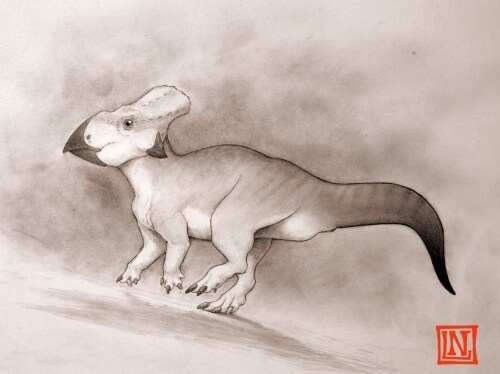"To study fossils from this period when the sea level was much higher than today and the land masses were fragmented can therefore be seen as independent experiments in the evolution of the dinosaurs. The dinosaurs on each continent evolved in other directions and there is still a lot to discover." says the lead researcher

A rare fossil from the east coast of North America of a horned dinosaur the size of a dog has been identified by scientists from the UK's University of Bath. The fossil provides evidence of an east-west divide in North America that influenced the evolution of dinosaurs.
During the late Cretaceous period 66-100 million years ago, the land mass that is now called North America was split into two continents when a shallow sea, the Western Interior Seaway, extended from the Gulf of Mexico to the Arctic Ocean. The dinosaurs that lived in the western continent, called Aramidia, were similar to those discovered in Asia.
However, very few fossils of any animals in the lost eastern continent of Appalachia have been discovered because these areas are covered with vegetation, making it difficult to discover and dig for fossils.
Dr Nick Longrich of the Milner Center for Evolution in the Department of Biology and Biochemistry at the University of Bath studied one of the rare fossils, a section of jawbone at the Peabody Museum at Yale University. It turns out that the bone belonged to a member of the horned dinosaur family - Ceratopsia. The study, published in the journal Cretaceous Research, places it as the first fossil of a caratopsian dinosaur identified from this period in Northeastern America.
Ceratopsia is a group of herbivorous horned dinosaurs that lived during the Cretaceous period. The studied fossil belonged to a smaller cousin of the triceratops genus - triceratopsids and was about the size of a large dog.
All continents were isolated
Dr. Longrich explains: "Just as we find unique animals and plants in Australia today that are different from those found in other parts of the world, it seems that the animals in the eastern part of North America in the late Cretaceous developed in a completely different way than those in the western part of North America, due The long period of isolation. This strengthens the theory that the two land masses were separated by a strip of water, which prevented animals from moving between them, and thus caused the animals in Appalachia to develop in a completely different direction, which was manifested in the strange shapes of the dinosaurs."
"To study fossils from this period when the sea level was much higher than today and the land masses were fragmented, so it can be seen as independent experiments in the evolution of the dinosaurs. The dinosaurs on each continent evolved in other directions and there is still a lot to discover."
to the notice of the researchers
More of the topic in Hayadan:

3 תגובות
the object of the obscurity of his name,
Great that you came! Slowly. Come to us on Saturday too. Look, feel, a little knowledge, a little intelligence and a little wisdom...slowly, slowly.
All your theories are just theories, there is no way it was millions of years ago, because the world has only existed for 5776 years and almost 3 months
Which one? Looks like Lucy's poodle.